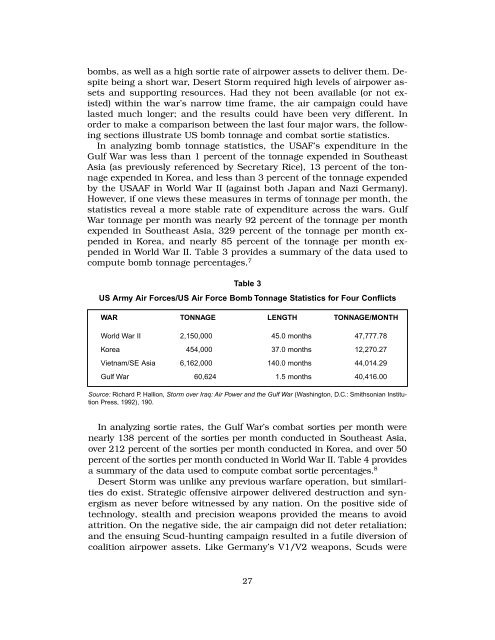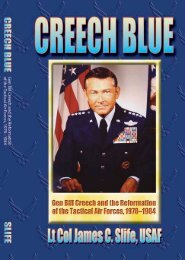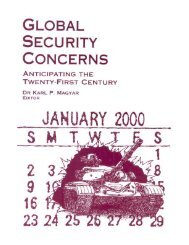Expendable Remotely Piloted Vehicles for Strategic Offensive ...
Expendable Remotely Piloted Vehicles for Strategic Offensive ...
Expendable Remotely Piloted Vehicles for Strategic Offensive ...
You also want an ePaper? Increase the reach of your titles
YUMPU automatically turns print PDFs into web optimized ePapers that Google loves.
ombs, as well as a high sortie rate of airpower assets to deliver them. Despitebeing a short war, Desert Storm required high levels of airpower assetsand supporting resources. Had they not been available (or not existed)within the war’s narrow time frame, the air campaign could havelasted much longer; and the results could have been very different. Inorder to make a comparison between the last four major wars, the followingsections illustrate US bomb tonnage and combat sortie statistics.In analyzing bomb tonnage statistics, the USAF’s expenditure in theGulf War was less than 1 percent of the tonnage expended in SoutheastAsia (as previously referenced by Secretary Rice), 13 percent of the tonnageexpended in Korea, and less than 3 percent of the tonnage expendedby the USAAF in World War II (against both Japan and Nazi Germany).However, if one views these measures in terms of tonnage per month, thestatistics reveal a more stable rate of expenditure across the wars. GulfWar tonnage per month was nearly 92 percent of the tonnage per monthexpended in Southeast Asia, 329 percent of the tonnage per month expendedin Korea, and nearly 85 percent of the tonnage per month expendedin World War II. Table 3 provides a summary of the data used tocompute bomb tonnage percentages. 7Table 3US Army Air Forces/US Air Force Bomb Tonnage Statistics <strong>for</strong> Four ConflictsWAR TONNAGE LENGTH TONNAGE/MONTHWorld War II 2,150,000 45.0 months 47,777.78Korea 454,000 37.0 months 12,270.27Vietnam/SE Asia 6,162,000 140.0 months 44,014.29Gulf War 60,624 1.5 months 40,416.00Source: Richard P. Hallion, Storm over Iraq: Air Power and the Gulf War (Washington, D.C.: Smithsonian InstitutionPress, 1992), 190.In analyzing sortie rates, the Gulf War’s combat sorties per month werenearly 138 percent of the sorties per month conducted in Southeast Asia,over 212 percent of the sorties per month conducted in Korea, and over 50percent of the sorties per month conducted in World War II. Table 4 providesa summary of the data used to compute combat sortie percentages. 8Desert Storm was unlike any previous warfare operation, but similaritiesdo exist. <strong>Strategic</strong> offensive airpower delivered destruction and synergismas never be<strong>for</strong>e witnessed by any nation. On the positive side oftechnology, stealth and precision weapons provided the means to avoidattrition. On the negative side, the air campaign did not deter retaliation;and the ensuing Scud-hunting campaign resulted in a futile diversion ofcoalition airpower assets. Like Germany’s V1/V2 weapons, Scuds were27






